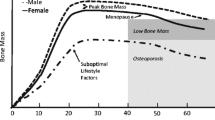Abstract
Summary
Osteoporosis is believed to be partly programmed in utero. Rat dams were given a low protein diet during pregnancy, and offspring were studied at different ages. Old aged rats showed site-specific strength differences. In utero nutrition has consequences in later life.
Introduction
Epidemiological studies suggest skeletal growth is programmed during intrauterine and early postnatal life. We hypothesize that age-related decrease in bone mass has, in part, a fetal origin and investigated this using a rat model of maternal protein insufficiency.
Methods
Dams received either 18% w/w (control) or w/w 9% (low protein) diet during pregnancy, and the offspring were studied at selected time points (4, 8, 12, 16, 20, 47, 75 weeks).
Results
Using micro-CT, we found that at 75 weeks of age female offspring from mothers fed a restricted protein diet during pregnancy had femoral heads with thinner, less dense trabeculae, femoral necks with closer packed trabeculae, vertebrae with thicker, denser trabeculae and midshaft tibiae with denser cortical bone. Mechanical testing showed the femoral heads and midshaft tibiae to be structurally weaker, whereas the femoral necks and vertebrae were structurally stronger.
Conclusions
Offspring from mothers fed a restricted protein diet during pregnancy displayed significant differences in bone structure and density at various sites. These differences result in altered bone characteristics indicative of significantly altered bone turnover. These results further support the need to understand the key role of the nutritional environment in early development on programming of skeletal development and consequences in later life.





Similar content being viewed by others
References
NIH Consensus development panel on osteoporosis prevention DaT (2001) Osteoporosis prevention, diagnosis, and therapy. JAMA 285:785–795
Ralston SH (1998) Do genetic markers aid in risk assessment? Osteoporos Int 8(Suppl 1):S37–S42
Cooper C, Cawley M, Bhalla A et al (1995) Childhood growth, physical activity, and peak bone mass in women. J Bone Miner Res 10:940–947
Cooper C, Fall C, Egger P et al (1997) Growth in infancy and bone mass in later life. Ann Rheum Dis 56:17–21
Cooper C, Javaid MK, Taylor P et al (2002) The fetal origins of osteoporotic fracture. Calcif Tissue Int 70:391–394
Fall C, Hindmarsh P, Dennison E et al (1998) Programming of growth hormone secretion and bone mineral density in elderly men: a hypothesis. J Clin Endocrinol Metab 83:135–139
Godfrey KM, Barker DJ (2000) Fetal nutrition and adult disease. Am J Clin Nutr 71(Suppl):1344S–1352S
Barker DJ (1992) The fetal origins of diseases of old age. Eur J Clin Nutr 46(Suppl 3):S3–S9
Mehta G, Roach HI, Langley-Evans S et al (2002) Intrauterine exposure to a maternal low protein diet reduces adult bone mass and alters growth plate morphology in rats. Calcif Tissue Int 71:493–498
Aihie S, Dunn R, Langley-Evans SC et al (2001) Prenatal exposure to a maternal low protein diet shortens life span in rats. Gerontology 47:9–14
Langley-Evans SC, Welham SJ, Sherman RC et al (1996) Weanling rats exposed to maternal low-protein diets during discrete periods of gestation exhibit differing severity of hypertension. Clin Sci (Lond) 91:607–615
Musha Y, Itoh S, Hanson MA et al (2006) Does estrogen affect the development of abnormal vascular function in offspring of rats fed a low-protein diet in pregnancy? Pediatr Res 59:784–789
Franco MdC, Arruda RM, Dantas APV et al (2002) Intrauterine undernutrition: expression and activity of the endothelial nitric oxide synthase in male and female adult offspring. Cardiovasc Res 56:145–153
Sun L, Peng Y, Sharrow AC et al (2006) FSH Directly regulates bone mass. Cell 125:247–260
Tobias JH, Cooper C (2004) PTH/PTHrP Activity and the programming of skeletal development in utero. J Bone Miner Res 19:177–182
Bourrin S, Toromanoff A, Ammann P et al (2000) Dietary protein deficiency induces osteoporosis in aged male rats. J Bone Miner Res 15:1555–1563
Gluckman PD, Hanson MA (2004) Living with the past: evolution, development, and patterns of disease. Science 305:1733–1736
Acknowledgements
This work was supported by a programme grant from Research into Ageing. We acknowledge useful discussion with Professors Mark Hanson, Nicholas Clarke and Dr Trudy Roach and the support of the Biomedical Research Facility. We thank statistician Karen Jameson from the MRC Epidemiology Resource Centre for helpful assistance with statistical analysis.
Conflict of interest statement
All authors have no conflicts of interest.
Author information
Authors and Affiliations
Corresponding author
Additional information
This work was supported by Research into Ageing.
Rights and permissions
About this article
Cite this article
Lanham, S.A., Roberts, C., Perry, M.J. et al. Intrauterine programming of bone. Part 2: Alteration of skeletal structure. Osteoporos Int 19, 157–167 (2008). https://doi.org/10.1007/s00198-007-0448-3
Received:
Accepted:
Published:
Issue Date:
DOI: https://doi.org/10.1007/s00198-007-0448-3




